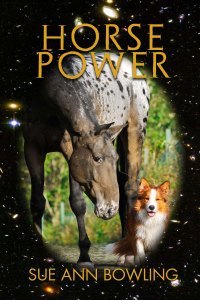For many years two types of “pinto” spotting were recognized—tobiano and overo. Overo has now been broken into a number of distinct spotting genes—frame, splash, sabino-1, other sabinos, polygenic sabino, some types of dominant white, and manchado. Sabino now seems to be as much a grab-bag of genetically different types of white markings as overo once was. Here I will concentrate on Sabino-1, while noting that several other genetic types of sabinos and dominant whites seem to be associated with mutations at nearly the same locus.
The sabino pattern has a wide variety of expressions, and some can be easily confused with other types of spotting, or even with roan. Sabinos not infrequently have areas of roaning as well as white spots, or flecks of color within the white areas. Almost all have white feet and facial markings, and the minimally marked ones can sometimes be detected by narrow extensions of the white up a leg or down the throat. The horse in the photograph to the right, for instance, has extensions of the high stockings in points up the legs as well as small white belly spots.
In contrast, tobianos tend to have white legs but relatively plain faces, while frame horses have heavily marked faces with generally dark legs. It is unlikely that a sabino would have a completely plain head or completely dark legs, but sabino can certainly mimic any of the other pinto patterns combined with normal face and leg markings.
The sabino-1 allele is due to a single base-pair change in intron 6 of the KIT locus on equine chromosome 3. This means it is very tightly linked with tobiano and roan, both of which are also associated with the KIT locus. There are actually a number of mutations at the KIT locus that can produce sabino-like patterns.
Sabino-1 is incompletely dominant to the wild-type allele. This means that a horse with one sabino-1 allele and one wild-type allele will be a typical sabino. A horse with two sabino-1 alleles may be mostly white, often with a pattern approximating the “War bonnet” pattern—color in a head bonnet, chest patch, flanks and tail base. This pattern, however, can also be produced by combining the tobiano and frame genes. Sabinos sometimes come from two parents that appear to be non-spotted, but as with tobianos, one parent is generally a minimally marked sabino.
Some of the other KIT-related sabino alleles may be lethal when the foal inherits them from both parents, but this is still being investigated. There is also the problem that it may not be possible to determine visually whether a sabino may have more than one spotting gene.
The sabino-1 allele is well known and a genetic test is available.











 Buy Homecoming from iUniverse
Buy Homecoming from iUniverse
















1 Trackback or Pingback for this entry:
[…] Sabino Spotting in Horses 2/6/11, 1/12/13 […]